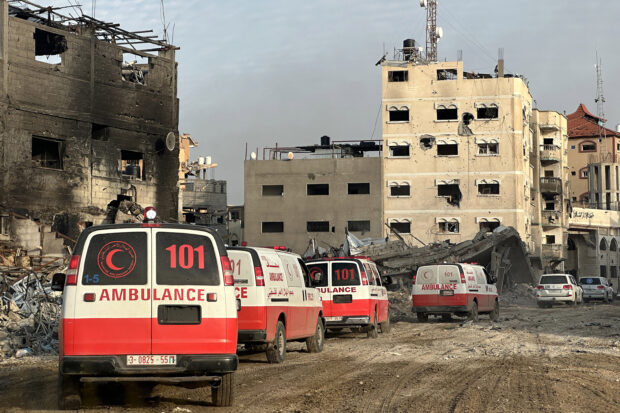What we know about Gaza aid convoy deaths

This handout photograph, taken on February 18, 2024 by the World Health Organization (WHO), shows a convoy of ambulances during a WHO, UN humanitarian agency OCHA and Palestinian Red Crescent mission to evacuate patients from Nasser hospital in Khan Yunis in the southern Gaza Strip, amid ongoing fighting between Israel and the Palestinian militant group Hamas. The World Health Organization said on February 20, 2024 it had transferred 32 patients out of the besieged Nasser Hospital in southern Gaza but said it feared for the patients and medics still inside. (Photo by Christopher Black / World Health Organization (WHO) / AFP)
Competing claims have emerged since dozens of people were killed in a scramble for aid in Gaza, with the Hamas-run territory’s health ministry saying Israeli forces shot them, but the army insisting most died in a stampede.
Here is what we know so far:
What happened?
A witness said thousands of people desperate for food had rushed towards aid trucks on Al-Rashid Road in Gaza city before dawn on Thursday.
“The soldiers fired at the crowd as people came too close to the tanks,” the witness told AFP, declining to be named for safety reasons.
An Israeli military official said there was an initial “stampede,” involving thousands of people. Part of the convoy had then managed to continue on its way.
“Dozens of civilians rushed to the trucks, approached the tanks and the forces nearby,” the official said.
“Soldiers fired warning shots in the air and then fired towards those that posed a threat and did not move away.”
“I can say we had a limited response, limited fire… It was not a massive event from our perspective.”
Aerial video released by the Israeli army showed what it said were scores of Gazans surrounding aid trucks in Gaza city.
But the black-and-white footage, which had no sound, raised many questions.
It does not include what happened at the start or end of the incident, and spots are blacked out or pixellated, with two areas appearing to show military vehicles on the edges of the aid convoy.
The Israeli army has yet to reply to an AFP request for more information.
How many were killed?
The health ministry in Hamas-run Gaza said 115 people were shot dead and more than 750 wounded.
An Israeli military spokesman, Rear Admiral Daniel Hagari, said “the unfortunate incident resulted in dozens of Gazans killed and injured.”
AFP images showed bodies wrapped in white shrouds at Gaza city’s Al-Shifa Hospital.
Hossam Abu Safiya, director of the city’s Kamal Adwan Hospital, said all the casualties were hit by “bullets and shrapnel from occupation forces.”
A UN team that visited the Al-Shifa on Friday saw a “large number of gunshot wounds” among survivors, UN Secretary-General Antonio Guterres’ spokesman said.
“This hospital is treating more than 200 people that were injured yesterday,” Georgios Petropoulos of the UN’s Office for the Coordination of Humanitarian Affairs (OCHA) said on Friday.
“We have seen people with gunshot wounds. We have seen amputees, and we have seen children as young as 12 that were injured yesterday.”
“These events cannot be allowed to go on. We need to have safe, secure passage throughout Gaza to reach the people that need humanitarian aid.”
How has the world responded?
Britain, France and Germany have called for an investigation into what happened, as have the European Union and African Union.
US President Joe Biden said his country would begin airdrops of aid to hard-to-reach parts of Gaza, which some other nations have already been doing.
Biden also said Washington would push Israel to let in more aid trucks and examine a possible “marine corridor” for aid.
Iran denounced “the barbaric attack by the Zionist regime.”
China said it was “shocked,” and the head of the Arab League said the “brutal” act showed “total contempt for human life.”
Colombia announced it was suspending the purchase of weapons from Israel.
Why are Gazans so desperate?
For months, aid workers have warned of an increasingly desperate situation for Gazan civilians, and this week a UN humanitarian official said widespread starvation was “almost inevitable.”
UN estimates show that 2.2 million people — the vast majority of Gaza’s population — are threatened with famine, particularly in northern areas around Gaza city.
Gaza’s health ministry on Friday reported a total of 13 children had died of “malnutrition and dehydration.”
According to the UN agency for Palestinian refugees, UNRWA, just over 2,300 aid trucks entered Gaza in February, a drop of about 50 percent compared with January.
That is an average of well below 100 trucks per day, down from around 500 that were entering daily before the war.
Who organized the convoy?
The Israeli army said the convoy of 38 trucks ferrying aid from Egypt had “entered Gaza for distribution by private contractors.”
Its spokesman Hagari said aircraft as well as tanks had been deployed to secure the convoy route but that there had been no air strike or tank fire towards the aid convoy.
He said troops had conducted similar convoy protection operations “the last four nights without any problem.”
Most Gaza aid convoys are organized by UN agencies, but in a post on X, UNRWA chief Philippe Lazzarini said: “Neither UNRWA nor any other UN agency were involved in this distribution.”
The trucks would have entered Gaza via the Rafah border crossing with Egypt before being checked by the Israeli authorities, but it remains unclear where the aid came from.
The aid trucks bore stickers of the Jamiya al-Umma non-governmental organization, but it is unclear which country they were from as it is a common name for NGOs across the region.
